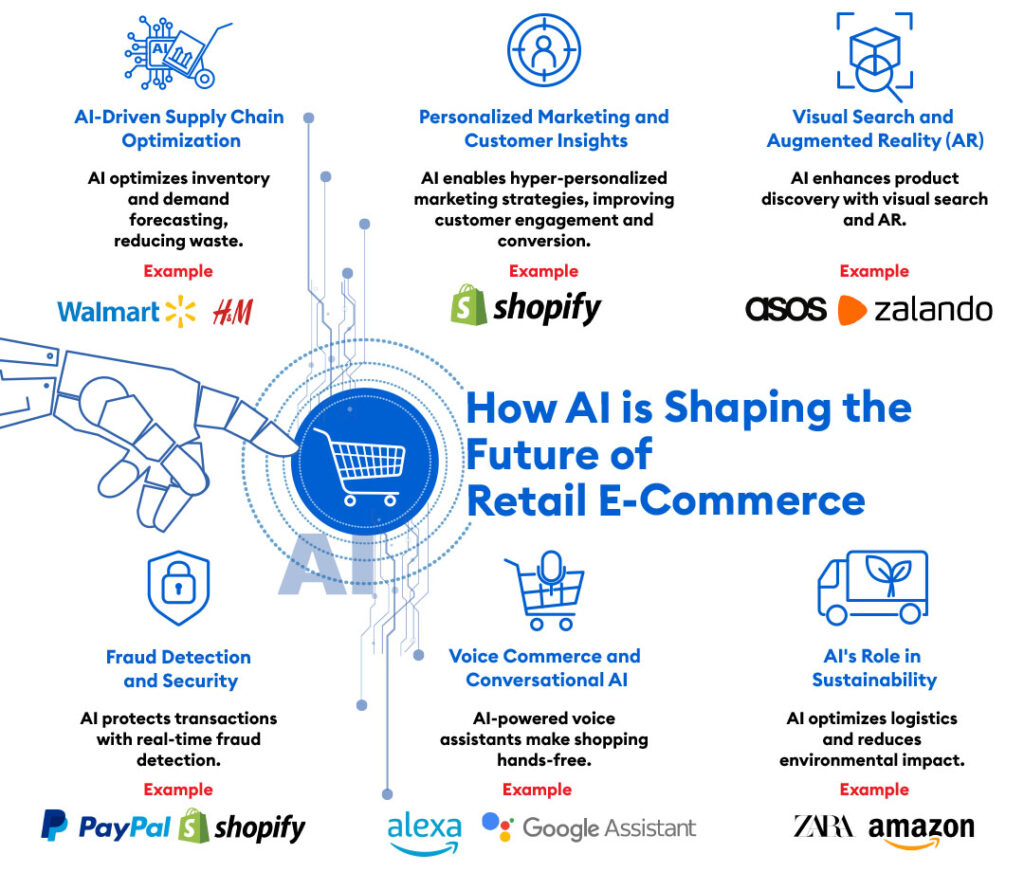Table Of Content
By 2028, global retail e-commerce sales are projected to reach $6.8 trillion, accounting for 24% of all retail sales worldwide, according to Forrester. 1 This rapid growth presents a significant opportunity for investors, particularly as artificial intelligence (AI) continues to transform the sector. AI is reshaping consumer behavior, optimizing operations, and unlocking new revenue streams, making the intersection of AI and e-commerce a crucial area for investment.

AI-Driven Supply Chain Optimization
AI is not only enhancing the customer experience but also revolutionizing back-end operations, particularly in supply chain management. Retail giants like Walmart and H&M have adopted AI to streamline inventory management and improve demand forecasting. By analyzing customer demand, historical sales data, and external factors like weather, AI predicts stock needs more accurately, ensuring retailers have the right products available at the right time. This reduces stockouts and excess inventory, improving operational efficiency while cutting costs, a key factor in maintaining competitive advantage in an increasingly dynamic market. 2
AI in Personalized Marketing and Customer Insights
AI is empowering retailers to create hyper-personalized marketing strategies that drive engagement and conversion. Using machine learning algorithms, businesses can analyze vast amounts of customer data to predict behavior, preferences, and purchasing patterns. Shopify, for example, uses AI-powered tools to send targeted marketing emails based on individual browsing and purchase histories. This level of personalization increases customer engagement and significantly boosts conversion rates. For investors, this means more efficient ad spending and higher returns on investment as businesses can deliver more relevant offers, directly impacting revenue growth.
AI-Powered Visual Search and Augmented Reality (AR)
AI-powered visual search and augmented reality (AR) are revolutionizing the shopping experience. Platforms like Zalando and ASOS now allow users to upload images of desired items and receive similar product recommendations, making product discovery more intuitive and engaging. Additionally, AI-powered AR tools, such as IKEA’s Place app, allow customers to visualize how products will look in their homes before purchase, merging online convenience with an in-store experience. These technologies not only enhance customer satisfaction but also increase sales by reducing the friction in the buying process. 3
Fraud Detection and Security
E-Fraud remains a major challenge in e-commerce, but AI is proving to be a critical tool in mitigating these risks. Platforms like PayPal and Shopify employ AI algorithms to analyze transaction patterns in real time, identifying suspicious activities and reducing fraud. AI-driven fraud detection systems lower chargebacks and financial losses for both retailers and consumers. As online transaction volumes continue to grow, AI’s role in securing financial data and maintaining consumer trust becomes even more critical, ensuring sustained business growth.
Voice Commerce and Conversational AI
Voice commerce is emerging as a key trend in e-commerce, driven by AI-powered voice assistants like Amazon Alexa and Google Assistant. These technologies allow users to search, order, and track purchases through simple voice commands, making the shopping experience faster and more convenient. As conversational AI evolves, retailers are integrating voice shopping into their platforms to meet growing consumer demand for hands-free, streamlined shopping experiences. This shift presents a new frontier for revenue generation, as businesses that embrace voice commerce can tap into an expanding market segment.
AI’s Role in Sustainability
AI is also playing a critical role in driving sustainability in retail. Brands like Zara and Amazon are leveraging AI to optimize logistics, reducing their carbon footprints by predicting demand more accurately and minimizing excess inventory. AI can track the environmental impact of supply chains and production processes, helping retailers make more sustainable choices. With increasing consumer demand for eco-friendly products, AI-driven sustainability initiatives are not only reducing costs but also enhancing brand loyalty, positioning businesses for long-term success in a competitive and socially conscious market.
Key Examples Where AI is Revolutionizing E-Commerce
Amazon’s Recommendation Engine
Amazon’s recommendation engine is one of the most powerful examples of AI-driven personalization in e-commerce. The system analyzes an individual’s browsing history, past purchases, and the behavior of similar customers to suggest relevant products. By leveraging machine learning algorithms, Amazon can make personalized recommendations in real time, which significantly increases the likelihood of converting casual browsing into sales. Even though these suggestions may seem subtle, they play a crucial role in influencing customer decisions, often without users consciously realizing it.
The impact of personalization is well-documented: up to 91% of online shoppers are more likely to engage with brands that offer a tailored experience, and 98% of e-commerce businesses report that personalization enhances their relationships with customers. 4 For Amazon, this translates into improved click-through rates, higher page views, and lower bounce rates. Personalization not only strengthens customer loyalty but also drives key metrics that are essential to maintaining Amazon’s competitive edge in the e-commerce landscape.
Alibaba’s AI-Driven Customer Service
Alibaba, China’s largest e-commerce company, handles a staggering volume of transactions on its Taobao platform, serving nearly one billion active consumers annually. During peak periods like the Double 11 shopping festival in 2021, Taobao facilitated transactions worth 540 billion RMB (US $85 billion) in just two days. 5
Managing this immense flow of customer interactions presents a significant challenge, making it difficult for Alibaba to engage with consumers in real time across its platform. To tackle this, Alibaba has implemented a suite of five AI chatbots designed to streamline customer service for both merchants and consumers.
These AI-powered chatbots cater to different needs across Taobao’s two-sided platform. The Wanxiang-bot assists merchants by resolving inquiries about platform rules, activities, and services, while the Alibee Shop bot supports merchants in handling direct consumer interactions and addressing service issues between buyers and sellers. For end-user consumers, Alibaba employs the Alime bot, which offers multi-channel support via online chat and phone hotlines. Alime’s rich interface allows for dynamic conversational exchanges, including text dialogues, images, videos, and even duplex voice interactions for users preferring phone consultations. Complementing Alime is the AI bot, which proactively mediates service disputes between consumers and merchants, leveraging transaction data and conversation history to make automated judgments and resolve cases efficiently.
Additionally, Alibaba uses the Dahuang-bot to train its customer service personnel. This bot simulates a diverse range of customer and merchant interactions, providing a more extensive and realistic training environment than traditional methods. Together, these AI-driven tools not only enhance Alibaba’s customer service capabilities but also improve operational efficiency, ensuring that both consumers and merchants receive timely and accurate support despite the platform’s massive scale.
Sephora’s Virtual Artist
Sephora’s Virtual Artist app revolutionizes the beauty industry by offering customers a highly interactive, virtual makeover experience that can be accessed anywhere. With the power of facial recognition technology, the app scans your face to detect key features like your eyes, lips, and cheeks, allowing you to virtually apply and experiment with an extensive library of makeup products, including eyeshadows, lip colors, and false lashes. Whether you’re torn between shades or finishes, like a KVD Vegan Beauty or Anastasia liquid lipstick, the app enables you to try on and compare products in real time before making a purchase decision. This virtual testing not only eliminates the need for physical samples but also enhances customer convenience and engagement by allowing them to explore infinite beauty options from the comfort of their homes. 6
Beyond virtual try-ons, Sephora’s Virtual Artist elevates the beauty experience with personalized, step-by-step tutorials that guide users through complex makeup techniques. These tutorials are tailored to your facial structure, showing exactly where to place products for flawless contouring, lip lining, or smoky eyes. The app also offers features like color matching your makeup to an outfit and comparing hundreds of color swatches instantly, giving users the power to test full looks, all in a virtual environment. This innovative use of augmented reality (AR) not only makes makeup shopping more fun and engaging but also empowers users to make more informed purchasing decisions, boosting customer satisfaction and brand loyalty.
Conclusion
The e-commerce landscape is undergoing a profound transformation, fuelled by the integration of AI technologies. AI is revolutionizing every aspect of retail, from streamlining supply chains and personalizing customer interactions to strengthening fraud prevention and driving sustainability efforts. With global e-commerce sales projected to reach $6.8 trillion by 2028, the growth potential presents a compelling opportunity for investors. 1 Companies like Amazon, Alibaba, and Sephora are harnessing AI to boost efficiency, enhance customer satisfaction, and establish themselves as frontrunners in the evolving retail landscape.

As AI continues to unlock new revenue streams, reduce operational costs, and foster innovation in sustainability, its role in the retail industry will become even more central. Investing in businesses at the forefront of AI adoption in e-commerce will likely yield significant long-term returns as these technologies drive future growth and competitive advantage.
- AI in E-Commerce: https://www.forrester.com/blogs/global-retail-e-commerce-sales-will-reach-6-8-trillion-by-2028/[↩][↩]
- AI in E-Commerce: https://www.prismetric.com/ai-in-retail-industry/[↩]
- AI in E-Commerce: https://www.ultralytics.com/blog/ai-in-fashion-retail[↩]
- AI in E-Commerce: https://stratoflow.com/amazon-recommendation-system/[↩]
- AI in E-Commerce: https://aibusiness.com/ml/the-alibaba-challenge-how-to-effectively-engage-with-a-billion-customers-[↩]
- AI in E-Commerce: https://www.sephora.sg/pages/virtual-artist?srsltid=AfmBOooZEo8UF4dR6Newcai5d-TcYn2CsiU6LYkFU_Ear0TSR4KP4g_F[↩]


